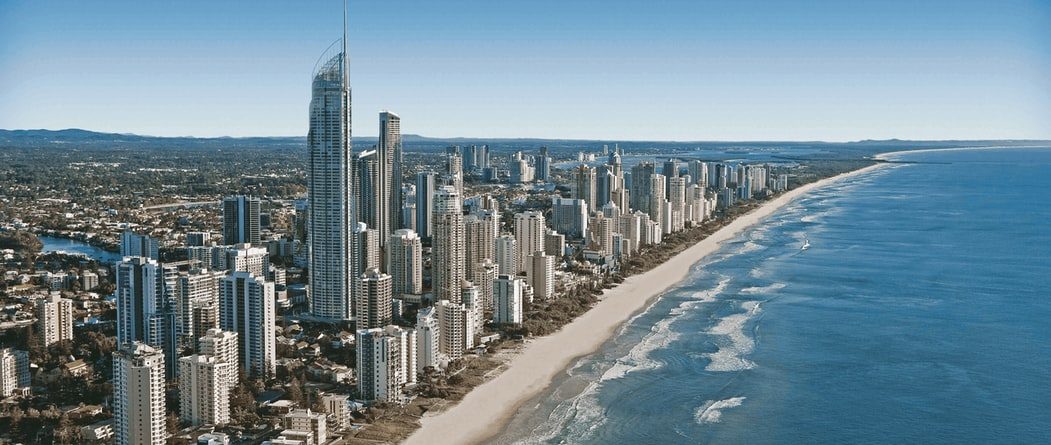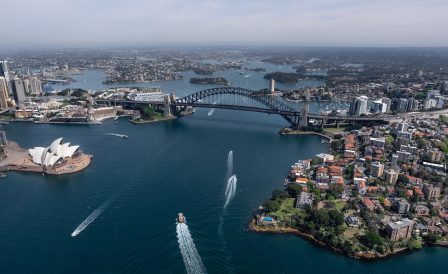When planning a move to Australia or choosing an educational provider, researching cities and choosing the most suitable place to live is crucial. There are more than a hundred cities and towns in Australia, and, of course, it is not possible to review all of them in one article. Therefore, we have selected what are, in our opinion, some of the most interesting places for you. In this article, you will find general information about lifestyle, job opportunities, and what you can do in your free time from work or study. We also collected statistics on property prices, average wages and unemployment rates.
Each city has its own vibe and meets the needs of different people. For example, Sydney and Melbourne are the biggest cities offering something for everyone. Those looking for a beach lifestyle are better off in the coastal towns of Queensland and New South Wales. For someone who prefers a quiet and safe atmosphere, and affordable prices, small inland cities may be more comfortable. This article will help you narrow your search for the best place for yourself. However, we advise you to further study the information about the city you are going to. This is just a brief overview.
Australia consists of six states and two territories:
- Australian Capital Territory
- New South Wales
- Queensland
- Victoria
- South Australia
- Western Australia
- Northern Territory
- Tasmania
Australian Capital Territory
Canberra
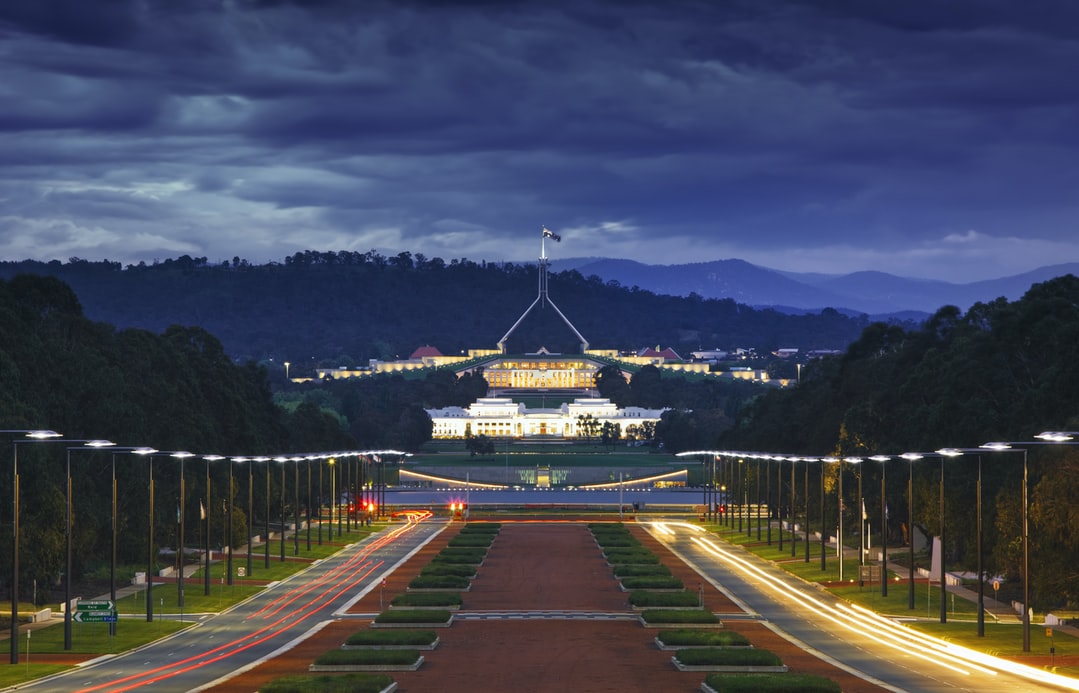
Population: 457,000
Average monthly salary (after tax): $5,050.20 AUD
Unemployment rate: 3.7% (as of July 2020, according to Labour Market Information Portal)
Price per square meter to buy an apartment outside of the centre: $4,435.22 AUD
The average summer temperature: 18 – +26 °C
The average winter temperature: – 1 – +12 °C
Canberra is the capital of Australia. It is the administrative centre for the Australian government. The embassies and main administrative offices have a strong impact on the Canberra lifestyle. The unemployment rate is lower, and pay rates are higher than the national average. Despite good salaries, rental prices in Canberra are relatively high due to the limited amount on the property market.
Since the city was founded in 1913 and built from scratch, its layout is characterised by the clear geometry of the streets and a large number of beautiful, monumental government buildings, national museums, galleries and memorials. Because of this, the Australian capital is often compared to the US capital, Washington D.C. For students wishing to study in Canberra, the doors of the Australian National University and the University of Canberra are always open.
New South Wales
Sydney
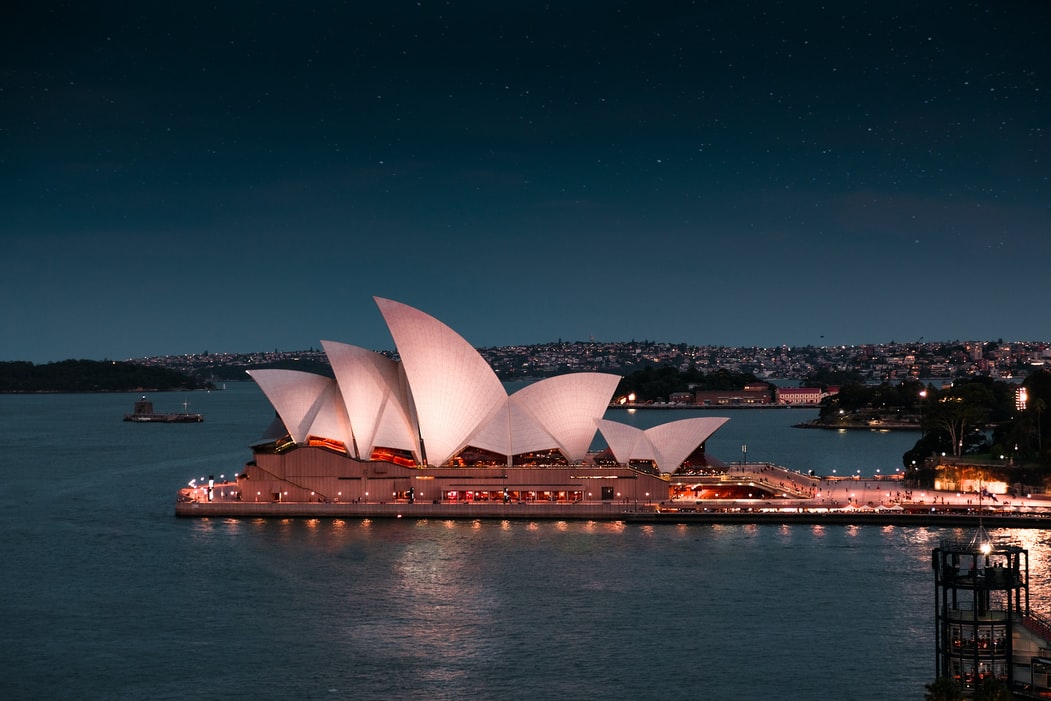
Population: 5.23 million
Average monthly salary (after tax): $5,461.92 AUD
Unemployment rate: 4.7% (as of July 2020, according to Labour Market Information Portal)
Price per square meter to buy an apartment outside of the centre: $8,100.00 AUD
The average summer temperature: 18.6 – 25.8 °C (water – 23 °C)
The average winter temperature: 8.8 – 17 °C (water – 17 °C)
Sydney is the largest city in Australia, ranked one of the top ten cities that are highly integrated into the global economy. Sydney has the largest market in IT, finance, education, medical, design and manufacturing. Nearly 40 per cent of the largest Australian head offices are located in Sydney. A wide range of employment opportunities attracts many professionals, business people and investors.
Famous attractions such as the Sydney Opera House, the Sydney Harbour Bridge, a colorful mix of different cultures and beautiful beaches attract millions of visitors every year.
Sydney is the highest-ranking city in the world for international students. It is home to such universities as:
- Australian Catholic University
- Macquarie University
- University of New South Wales
- University of Sydney
- University of Technology, Sydney
- University of Western Sydney
However, Sydney is the most expensive Australian city and one of the most expensive in the world, especially in terms of renting and buying properties. This should be considered before moving to Sydney.
Newcastle
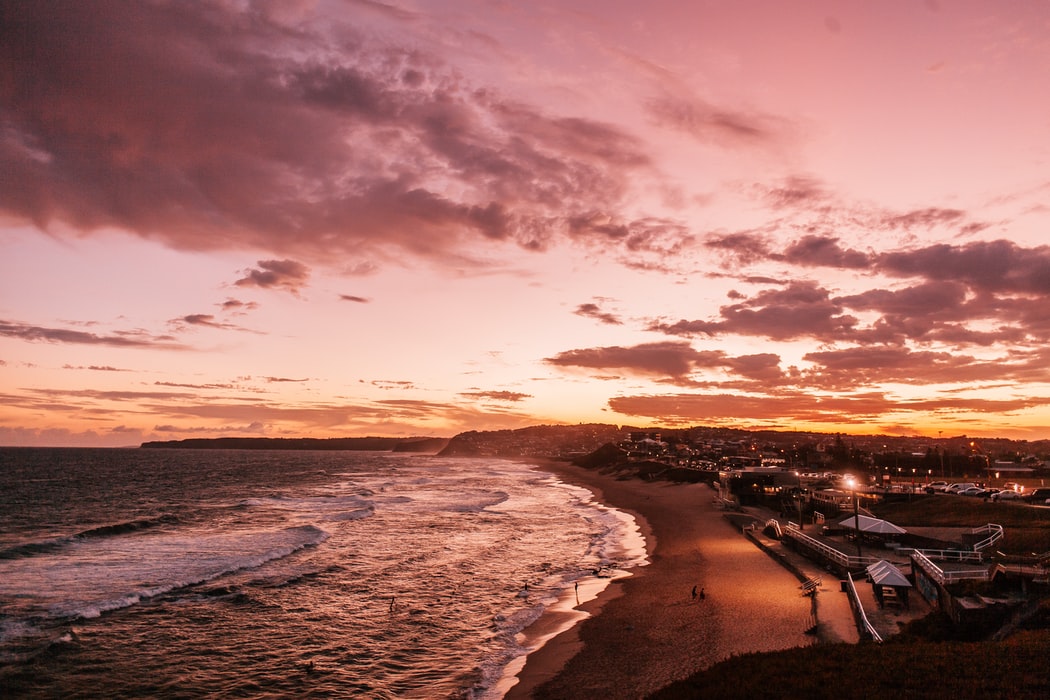
Population: 450,360
Average monthly salary (after tax): $5,556.25 AUD
Unemployment rate: 5.7% (as of July 2020, according to Labour Market Information Portal)
Price per square meter to buy an apartment outside of the centre: $4,066.67 AUD
The average summer temperature: 20 – 40 °C (water – 24 °C)
The average winter temperature: 8.5 – 18 °C (water – 19 °C)
A city with beautiful beaches, unique architecture and a long history is a two-hour drive north of Sydney. The population of Newcastle has been constantly growing for the last decade. Some people like it because the cost of living is lower than Sydney. At the same time, Newcastle has much to offer its residents. The city has a rich cultural life with museums, art galleries, theatres and music festivals. Fantastic nature gives wide opportunities for different kinds of sports and leisure — surfing, kitesurfing, kayaking, whale watching, trekking, mountain biking and so on. Newcastle has the famous seven mile beach.
The University of Newcastle offers a variety of study programs in different fields, such as business, law, engineering, construction, science, medicine, computing and creative industries. The university facilities are also impressive and include a concert hall (a part of The Conservatorium), a swimming pool, a climbing wall, a gym and courts.
Wollongong
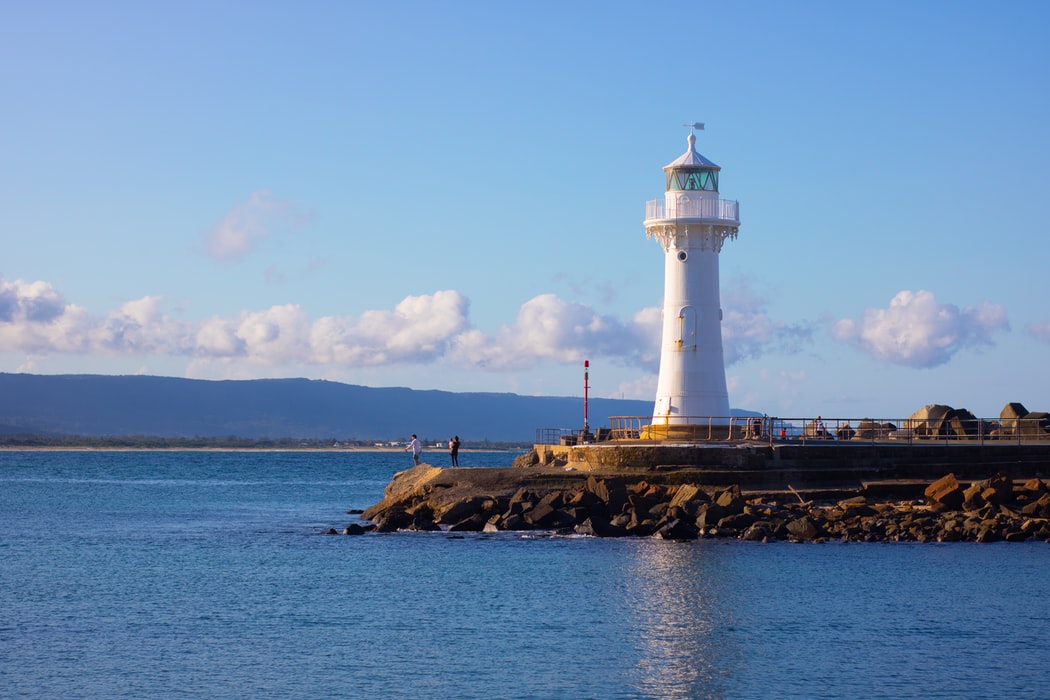
Population: 305,300
Average monthly salary (after tax): $4,741.17 AUD
Unemployment rate: 6.6% (as of July 2020, according to Labour Market Information Portal)
Price per square meter to buy an apartment outside of the centre: $6,000.00 AUD
The average summer temperature: 15 – 30 °C (water – 23 °C)
The average winter temperature: 8 – 19 °C (water – 19 °C)
Another coastal city, just 68 km south of Sydney, it attracts skilled people, students and tourists from all over the world. Many people come here for job opportunities in manufacturing, logistics, education, tourism and hospitality.
The city is also home to The University of Wollongong, which is in the top 20 best modern universities in the world and has around 37,000 students. Therefore, Wollongong is a lively city with a young, multicultural population.
Wollongong’s climate is slightly cooler than in Sydney. However, in winter (July-August), it is very windy. The city has also experienced floods in the past, so authorities are taking all necessary measures to prevent floods in the future.
Beaches and mountains, rainforests and waterfalls, a lighthouse and one of the famous coastal roads, botanic gardens, art galleries and the largest Buddhist temple in the southern hemisphere attracts many visitors and students who study at the University of Wollongong, which offers a wide range of disciplines in engineering and IT, health sciences and medicine, business and commerce, arts, law and education.
Armidale
Population: 30,800
Average monthly salary (after tax): $5,765.83 AUD
Unemployment rate: 5.7% (as of July 2020, according to Labour Market Information Portal)
Price per square meter to buy an apartment outside of the centre: $2,700.00 AUD
The average summer temperature: 13 – +30 °C
The average winter temperature: -5 – +16 °C
Armidale is a popular country town, approximately halfway between Sydney and Brisbane. The main industries in the town are education, healthcare and agriculture. Founded in the19th century, Armidale has a large number of old buildings and cathedrals, Many of them are protected as historical heritage.
Armidale has a campus for the University of New England with 22,500 students and offers very strong education and research programs in rural science, environmental science and agriculture. The university is also the biggest employer in the town, providing jobs to thousands of people.
Bathurst
Population: 36,800
Average monthly salary (after tax): $3,583.33 AUD
Unemployment rate: 4.0% (as of July 2020, according to Labour Market Information Portal)
Price per square meter to buy an apartment outside of the centre: $2,700.00 AUD
The average summer temperature: 11 – 30 °C
The average winter temperature: -5 – 13 °C
Once upon a time, the first settlers found gold in Bathurst, which many people. So the gold rush contributed to the city’s development. Now the main contributor to the Bathurst economy is education. The second largest sectors are the manufacturing industry and government service, followed by agriculture and forestry.
The city’s claim to fame is motorsport. Massive motorcycle races take place there at least three times a year, and during this time, the city is full of tourists and fans of the sport. In general, Bathurst pays special attention to sports. In addition to motorcycle racing, rugby, athletics, cricket, cycling and BMX are very popular there.
The city is home to the main campus of Charles Sturt University, which prides itself in its high graduate employability and the quality of online programs. There are also two campuses for The Western Institute of TAFE, and Western Sydney University, has a clinical education facility housed within Bathurst Hospital for its medical students.
Lismore
Population: 43,700
Average monthly salary (after tax): $2,400 AUD
Unemployment rate: 4.7% (as of July 2020, according to Labour Market Information Portal)
Price for a house outside of the centre: $417,178 AUD
The average summer temperature: 20 – 35 °C
The average winter temperature: 6 – 25 °C
The city is located in the northeast of New South Wales on the banks of the Wilsons River. With a humid subtropical climate, it is never too cold in Lismore. However, heavy rains are quite frequent, especially in summer. The city is located in the lowlands, so it’s prone to flooding. The last major flood occurred in 2017, after Cyclone Debbie.
The main sectors of the city’s economy are health, education, social services and retail trade. The construction, finance and property spheres are actively growing as well.
Lismore is also home to Southern Cross University. Ranked in the top 100 young universities in the world, it has amazing facilities for comfortable and exciting student life: landscaped gardens and rainforest walkways, a gym, heated indoor swimming pool, health clinic, science laboratories with the latest equipment and so on.
Dubbo
Population: 53,719
Average monthly salary (after tax): $3,893 AUD
Unemployment rate: 1.4% (as of July 2020)
Median house price: $365,000 AUD
The average summer temperature: 17 – 31 °C
The average winter temperature: 3 – 16 °C
Dubbo is situated in the heart of NSW. This city is very attractive to families as it combines a friendly, welcoming environment with excellent career opportunities, services and entertainment. Dubbo is a lively regional centre with well-developed engineering, construction, education, healthcare, mining, manufacturing, transport and logistics industries. Thus, more and more people are moving to Dubbo, as there is a good chance of finding a job, and housing prices are much lower than in big cities.
The city’s location is very convenient, as three major highways pass through it. Dubbo also has an airport with regular air service connecting the city with Brisbane, Newcastle, Sydney, Melbourne, Cobar, Broken Hill, Bourke and Walgett. Moreover, there is a train from Sydney Central (via Wellington) to Dubbo. The city is also a popular travel destination for holidays because there are plenty of attractions for families including the famous Taronga Western Plains Zoo with lions, elephants, cheetahs, tigers, giraffes, zebras, koalas, kangaroos and 350 other species.
Four tertiary institutions have their campuses in Dubbo: Charles Sturt University, School of Rural Health (University of Sydney), TAFE NSW Western Institute and Alesco Learning Centre.
Coffs Harbour
Population: 74,641
Average monthly salary (after tax): $4,270 AUD
Unemployment rate: 8% (as of July 2020)
Median house price: $468,952 AUD
The average summer temperature: 19 – 28 °C
The average winter temperature: 8 – 19 °C
Coffs Harbour is a city on the seashore between Newcastle and the Gold Coast. The leading online travel website Wotif.com called it “Aussie Town of the Year 2020” thanks to plenty of attractions and activities for tourists: bushwalking, whale watching, scuba diving, stunning beaches, national parks, reserves and marine parks.
Among popular destinations are the Dolphin Marine Conservation Park, Coffs Harbour Butterfly House, Solitary Islands Aquarium and Treetops Adventure Park. But the most famous site is the Big Banana, one of the oldest and most visited “big things” in Australia. It refers to a time when the banana industry was the main part of the city’s economy. And the Big Banana Fun Park with 4D Ride Simulator, water park, mini-golf course, laser tag arena and an ice skating rink is the most popular holiday destination for families with children.
In Coffs Harbour, there is a campus for Southern Cross University, a rural faculty of medicine for the University of New South Wales, TAFE NSW and some private colleges delivering accredited courses in business, management, retail and hospitality.
Queensland
Brisbane
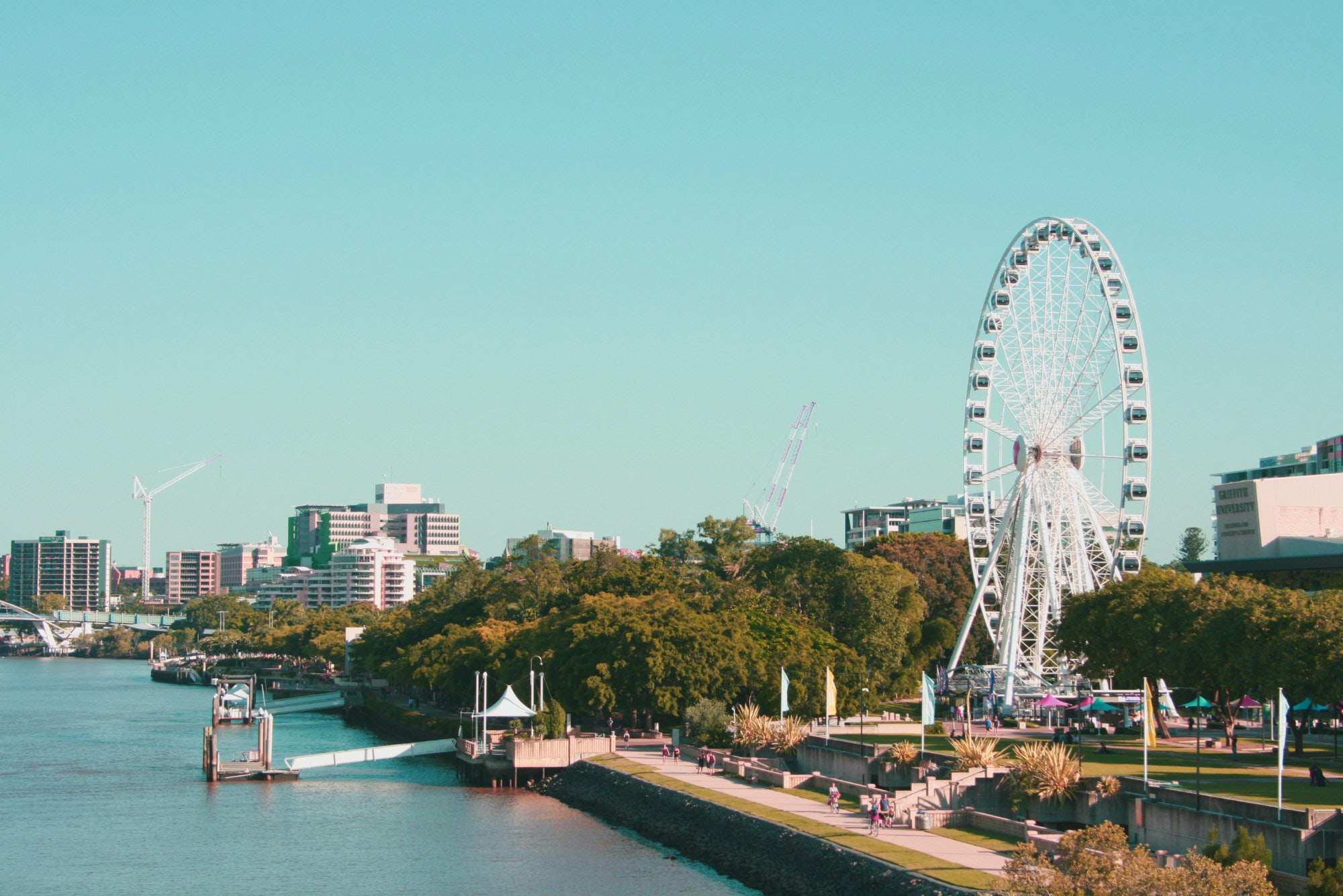
Population: 2.27 million
Average monthly salary (after tax): $4,671.57 AUD
Unemployment rate: 6.7% (as of July 2020, according to Labour Market Information Portal)
Price per square meter to buy an apartment outside of the centre: $4,100.00 AUD
The average summer temperature: 21 – 29.8 °C (water – 27 °C)
The average winter temperature: 11 – 21 °C (water – 21 °C)
Brisbane is the capital of Queensland and the third most populous city in Australia. It is also a Global City with great opportunities for business and international trade. The largest industries are healthcare, education and professional, scientific and technical services. The last one is experiencing the highest growth.
Brisbane is a popular tourist destination. It attracts over nine million visitors each year. The city has everything for a comfortable and exciting time. Cafes and restaurants amaze with excellent coffee and delicious food, shopping malls delight with a variety of brands, parks and museums continuously host interesting events with live music and performances.
Brisbane’s climate, with long, hot summers, short warm winters and 300 sunny days a year makes this city perfect for outdoor activities and sports.
In Brisbane, there are three big universities with high world rankings:
- University of Queensland
- Queensland University of Technology
- Griffith University
Gold Coast
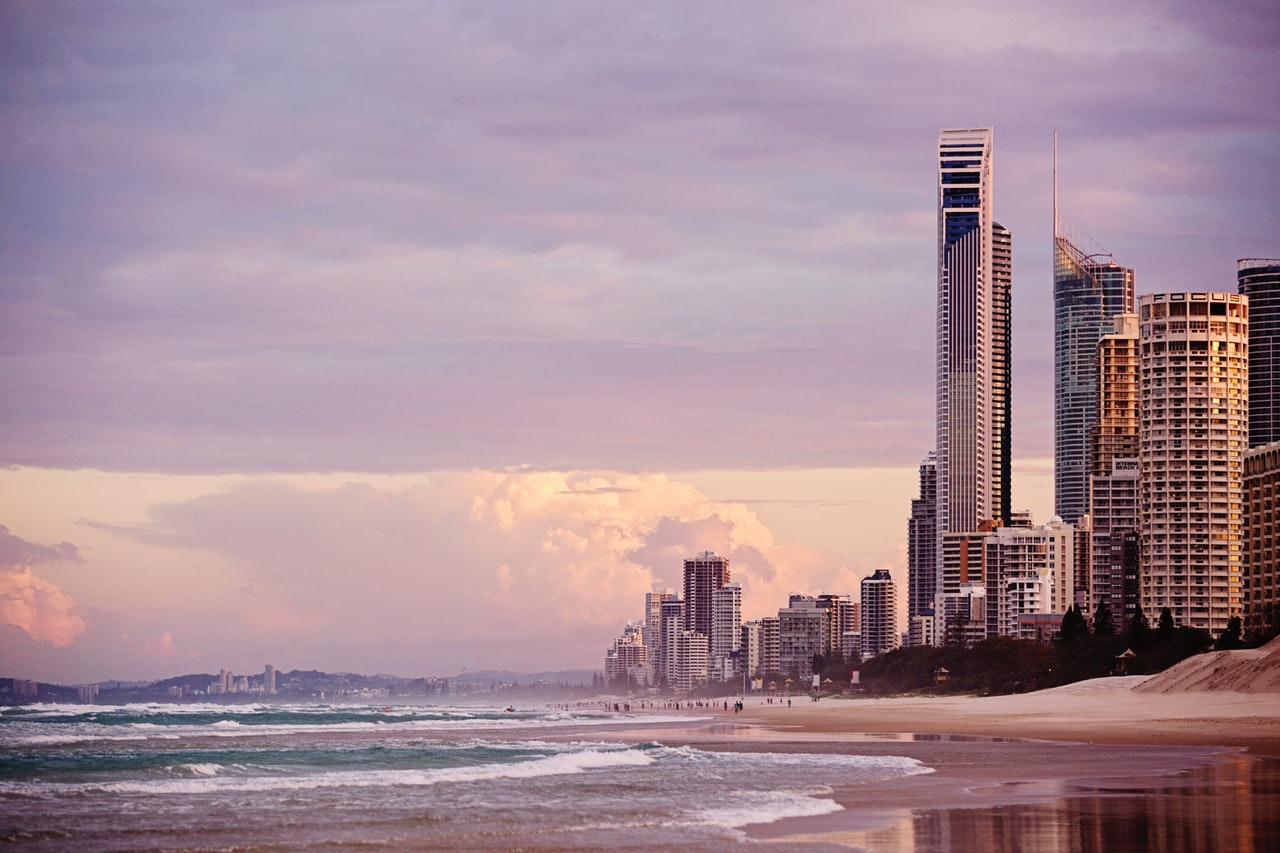
Population: 699,000
Average monthly salary (after tax): $5,054.18 AUD
Unemployment rate: 6.3% (as of July 2020, according to Labour Market Information Portal)
Price per square meter to buy an apartment outside of the centre: $5,383.33 AUD
The average summer temperature: 20 – 30 °C (water – 27.1 °C)
The average winter temperature: 10 – 22 °C (water – 21.5 °C)
A surfers’ paradise with 57 kilometres of picturesque beaches and a hot, sunny climate is located 66 kilometres south of Brisbane. Gold Coast is one of the most popular tourist destinations, hosting about 10 million visitors a year. The region is developing at a frantic pace because it attracts people with great job opportunities in the growing tourism industry. Gold Coast is also known as “Australia’s Hollywood” for its massive TV, film and music productions. Therefore, it can offer jobs for professionals in creative and media spheres. Other big industries in the city are education, IT, hospitality, environment and sports.
Gold Coast is not only famous for its beaches and surfing. It offers one of the biggest ranges of entertainment among Australian cities. Rainforests with waterfalls, numerous theme parks, cultural spaces and events and a jaunty nightlife make this city perfect for young people.
Gold Coast is home to Bond University, a private university famous for its accelerated programs and high-quality legal education.
Sunshine Coast
Population: 346,829
Average monthly salary (after tax): $4,776.67 AUD
Unemployment rate: 8.3% (as of July 2020, according to Labour Market Information Portal)
Price per square meter to buy an apartment outside of the centre: $4,166.67 AUD
The average summer temperature: 20 – 30 °C (water – 27.1 °C)
The average winter temperature: 7 – 22 °C (water – 21.2 °C)
Sunshine Coast is not actually a city. This area is a conglomerate of small towns interspersed with rural landscapes. The geographic centre and the heart of the region is the town Maroochydore with a population of 16,800 people.
The Sunshine Coast is an actively developing region that is known as a centre for innovation. Local government attracts investments and encourages startups in key sectors of the region’s economy: healthcare, education, finance, IT, clean technologies and sustainability, tourism, agriculture and horticulture. Therefore, the Sunshine Coast provides good opportunities for investors, entrepreneurs and job-seekers.
The Sunshine Coast is also a centre for tourism, offering a wide range of interesting places and activities. Here you can visit the Australia Zoo, Sea Life marine park, swim with whales, go sailing, deep-sea fishing and, of course, surfing. The region hosts numerous food and art festivals annually and big sports events like the Noosa Festival of Surfing, Velothon Sunshine Coast, Mooloolaba Triathlon, Noosa Triathlon and Sunshine Coast Marathon.
The main higher education provider in the region is the University of the Sunshine Coast, which has its main campus at Sippy Downs, along with many campuses across Queensland.
Rockhampton
Population: 80,665
Average monthly salary (after tax): $4,000 AUD
Unemployment rate: 6.5% (as of July 2020, according to Labour Market Information Portal)
Price for a house outside of centre: $268,457 AUD
The average summer temperature: 22 – 32 °C
The average winter temperature: 9 – 23 °C
Rockhampton is referred to as the unofficial capital of Central Queensland. It is the industrial and agricultural centre of the region. Agriculture, manufacturing, tourism and hospitality, construction, transportation and energy are the key industries there.
A beautiful town located on the Fitzroy River and surrounded by mountains, Rockhampton is also well-known for its dainty architecture as a lot of Victorian-era buildings have survived there. Among other tourist attractions are Rockhampton Art Gallery, Pilbeam Theatre, Dreamtime Cultural Centre, Botanic Gardens, Zoo, Capricorn Caves and more.
Central Queensland University, which has many campuses across Australia, has its main campus in Rockhampton.
Toowoomba
Population: 121,020
Average monthly salary (after tax): $3,916.67 AUD
Unemployment rate: 5.6% (as of July 2020, according to Labour Market Information Portal)
Price for a house outside of centre: $268,457 AUD
The average summer temperature: 16 – 29 °C
The average winter temperature: 5 – 18 °C
Toowoomba is located 127 km from Brisbane, and it is the second most populous inland city in Australia. It is also known as the “Garden City” because there are over 240 public parks and gardens. Toowoomba is a family-friendly city, offering a relaxed, calm and safe atmosphere. At the same time, Toowoomba’s economy is quite diverse. People mostly work in retail, healthcare, finance, engineering, education, transport, mining, agriculture and manufacturing.
Each September, Toowoomba hosts the Carnival of Flowers — the biggest flower event in Australia, which attracts visitors from all over the country. Another popular attraction is the Great Dividing Range views from Picnic Point Lookout and Parkland. The breathtaking panoramic view covers the Main Range and the Lockyer Valley. It is also interesting to walk around the city, as there are many historical buildings with fascinating architecture and street art.
Toowoomba takes pride in its high-quality educational institutions. One of them is the University of Southern Queensland, which has its main campus there.
Cairns
Population: 154,230
Average monthly salary (after tax): $4,183 AUD
Unemployment rate: 6.1% (as of July 2020)
Price per square meter to an apartment outside of the centre: $2,833.33 AUD
The average summer temperature: 24 – 32 °C
The average winter temperature: 17 – 26 °C
Cairns is a tropical tourist city offering a relaxed lifestyle full of adventure. A lot of tourists, students and scientists come here for the Great Barrier Reef — one of the richest and most diverse ecosystems in the world listed as a UNESCO World Heritage site. You can explore it while diving and snorkelling or take a boat or even a helicopter.
Another UNESCO World Heritage site, Daintree and Wet Tropics rainforest is also situated near Cairns. It is 100 million years old, and it’s full of the broadest range of plants and animals in the world, including endangered ones.
Apart from World Heritage sites, there is lots to see in the city: Kuranda Koala Gardens, Cairns Botanic gardens, Cairns Aquarium and local Indigenous villages that keep their unique culture.
The city itself is very modern and clean. It has numerous beaches, sport and recreation facilities and a gorgeous esplanade along the waterfront with cafes, bars and restaurants. Tourism and hospitality are key industries in Cairns, followed by agriculture, education and healthcare.
There is a James Cook University campus, a Central Queensland University study centre and a TAFE college for those who want to study in Cairns.
Townsville
Population: 185,000
Average monthly salary (after tax): $3,225.00 AUD
Unemployment rate: 7.3% (as of July 2020, according to Labour Market Information Portal)
Price per square meter to buy an apartment outside of the centre: $4,000.00 AUD
The average summer temperature: 24 – 33 °C (water – 28 °C)
The average winter temperature: 13 – 26 °C (water – 22.5 °C)
According to its citizens, Townsville is the unofficial capital of North Queensland. There are many government, administrative and business offices, well-developed zinc, nickel and copper refinery industries and a port, which plays a significant role in international trade with Asian countries, especially China.
At the same time, Townsville is a tropical city with a hot and humid climate and more than 300 days of sunshine per year. So, the lifestyle is pretty laid back there, and the town provides all the necessary facilities for recreation and entertainment.
The most significant advantage of Townsville is access to the central section of the Great Barrier Reef. For that reason, James Cook University, located in this city, is famous for its strong education and research programs in marine biology. Townsville is also home to the Australian Institute of Marine Science (50 km outside the city) and the world’s largest living coral reef aquarium.
Victoria
Melbourne
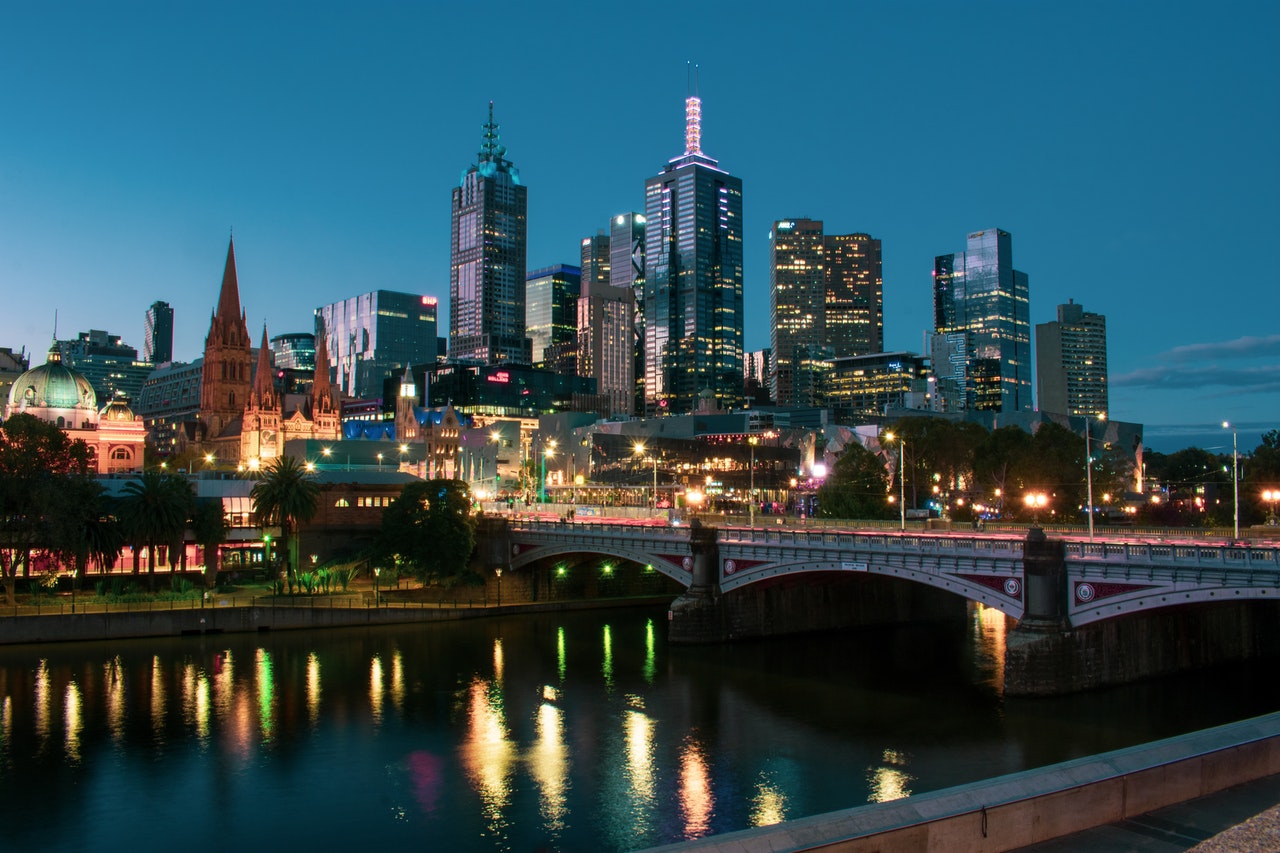
Population: 4.96 million
Average monthly salary (after tax): $5,059.43 AUD
Unemployment rate: 5.2% (as of July 2020, according to Labour Market Information Portal)
Price per square meter to buy an apartment outside of the centre: $8,061.05 AUD
The average summer temperature: 14 – 25.3 °C (water – 18 °C)
The average winter temperature: 6.5 – 14.2 °C (water – 14.6 °C)
Melbourne is the capital of the state of Victoria and the second-most populous city in Australia after Sydney. Multinational, creative and innovative, it has a unique atmosphere and is continuously ranked as one of the world’s most comfortable cities for living. The top 3 industries in Melbourne are finance and insurance, science and technology, and accommodation and food.
Melbourne is famous for its high concentration of fantastic bars and restaurants, numerous shopping malls, boutiques and markets, cultural events, street art and live music. You will never be bored in Melbourne.
The weather in the city is never too cold or too hot. However, it can change suddenly during the day. Locals even joke that in Melbourne, you can have “four seasons in one day”. So, even if it’s sunny, it’s best to take an umbrella and wear a few layers.
Melbourne is also the educational centre of the state. About 80,000 international students study there in different universities:
- Deakin University
- La Trobe University
- RMIT University
- Monash University
- Swinburne University of Technology
- University of Divinity
- University of Melbourne
- Victoria University
Geelong
Population: 200,474
Average monthly salary (after tax): $3,050.00 AUD
Unemployment rate: 4.4% (as of July 2020)
Price per square meter to buy an apartment outside of the centre: $5,473.12 AUD
The average summer temperature: 13 – 25 °C
The average winter temperature: 6 – 15 °C
Geelong is a port city less than an hour’s drive from Melbourne. It is the second-largest city in Victoria and the second-fastest growing in Australia. Rapid growth gives impetus to the active construction and development of other spheres of urban life. The city’s economy is mainly based on manufacturing, retail, healthcare and community services.
Tourism is also an essential part of the city. Geelong is the gateway to the Great Ocean Road, famous for spectacular views of the Southern Ocean coast. Many visitors also come to see the National Wool Museum, the Old Geelong Gaol, the Botanic Gardens and Eastern Beach, and to walk among historic buildings recognised as Victorian heritage and enjoy beaches and wineries around the Bellarine Peninsula.
Due to its manufacturing past, Geelong has some industrial spaces that have been renovated into cafes, bars, restaurants, pubs, nightclubs and galleries. The city has a vibrant music atmosphere with regular live concerts and a large number of music festivals. Geelong gave birth to many bands and musicians famous in Australia.
Sports are also very active in the city. The Geelong Football Club, nicknamed the Geelong Cats, a professional Australian rules football club, is one of the world’s oldest. The city also has a strong basketball team, the Geelong Supercats and many sports clubs of different kinds: soccer, rugby, cricket, horse-racing, tennis, etc. The location of Geelong on the bay provides excellent opportunities for water activities such as surfing, kayaking, scuba diving and dolphin watching.
Deakin University has two state-of-the-art campuses in Geelong. More than 4,000 students study nursing, medicine, engineering, IT, sport, science and arts, enjoying modern facilities for learning and recreation.
Ballarat
Population: 109,505
Average monthly salary (after tax): $4,000 AUD
Unemployment rate: 4.3% (as of July 2020, according to Labour Market Information Portal)
Price for a house outside of the centre: $395,000 AUD
The average summer temperature: 9 – 26 °C
The average winter temperature: 2-12 °C
Ballarat is a city that is a 1.5 hours drive from Melbourne, which has preserved its history and architecture since the gold rush of the mid-19th century. The city is renowned for its rich cultural life with museums, historical sites, theatres, theme parks and Victorian buildings. Nature lovers will also enjoy this city. It has a wildlife park with rare animals, a botanical garden and the scenic surroundings of Lake Wendouree.
The key industries in the city are tourism, hospitality, retail, education, construction, manufacturing, mining and agriculture. The Ballarat region also has a rapidly growing renewable energy industry.
Ballarat is home to the Federation University of Australia, established in 1870.
South Australia
Adelaide
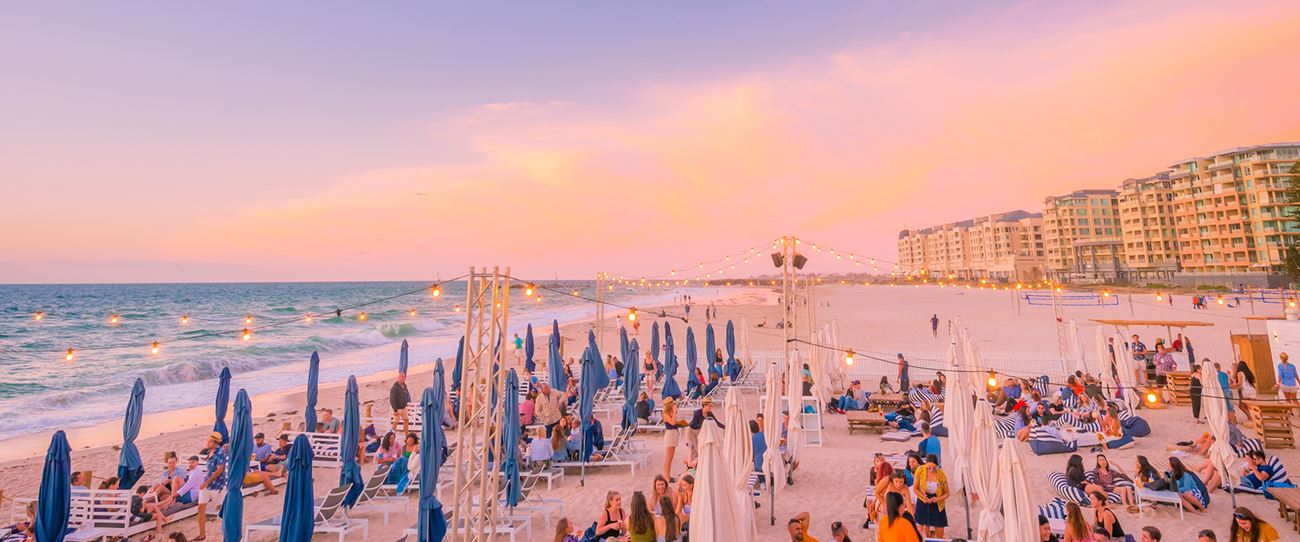
Population: 1.34 million
Average monthly salary (after tax): $4,472.46 AUD
Unemployment rate: 6.2% (as of July 2020, according to Labour Market Information Portal)
Price per square meter to buy an apartment outside of the centre: $3,394.00 AUD
The average summer temperature: 16.7 – 28.6 °C (water – 20 °C)
The average winter temperature: 8 – 16 °C (water – 14 °C)
Adelaide is the capital of South Australia and the fifth most populous city in the country. It has a diverse and multicultural population — about 30 per cent of the people living in Adelaide are foreign-born. According to Numbeo, Adelaide has the second-highest quality of life index in the world, and it continually occupies positions in the top 10 most comfortable cities to live in according to different world rankings.
In 2015, Adelaide was designated UNESCO City of Music in Australia. Indeed, the city has a rich music culture and a high concentration of live music venues and events. It also offers lots of arts, entertainment and a thriving nightlife.
If you want to study in one of the best cities in the world, here is the list of universities located in Adelaide:
- Carnegie Mellon University
- Flinders University
- University of Adelaide
- University College London
- University of South Australia
- Torrens University Australia
Western Australia
Perth
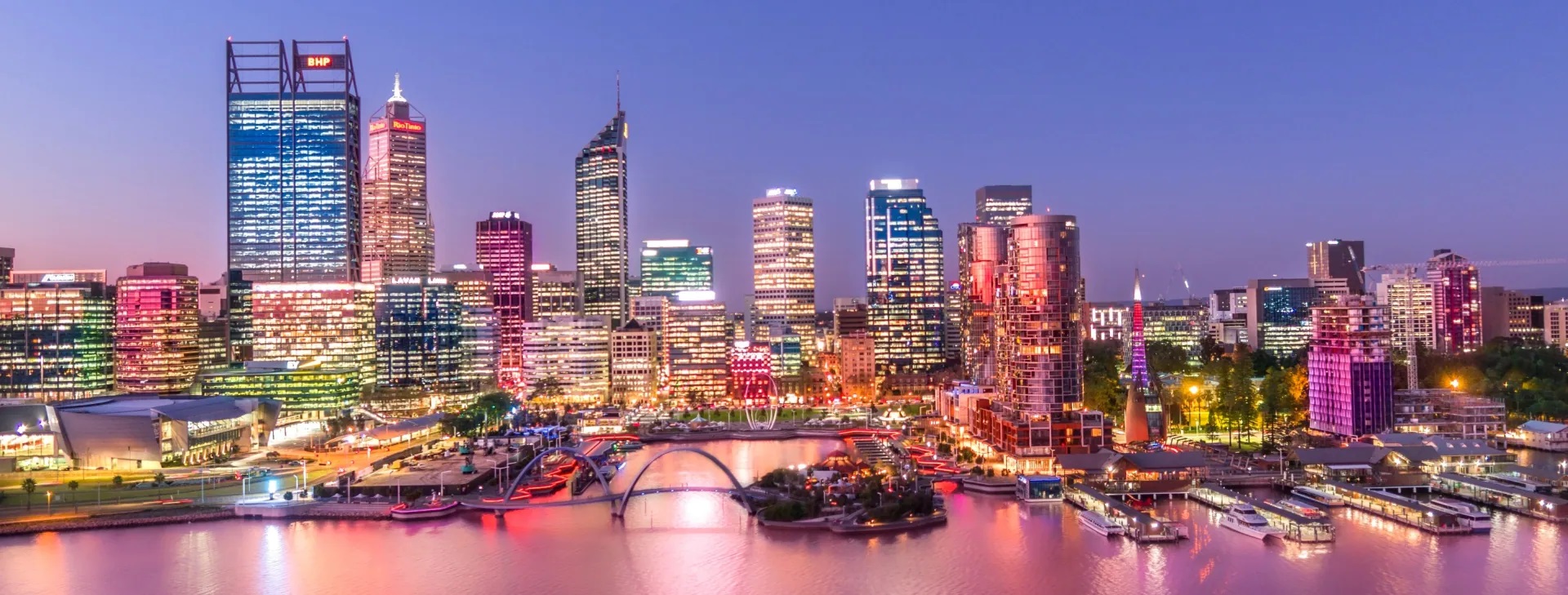
Population: 2.04 million
Average monthly salary (after tax): $4,506.15 AUD
Unemployment rate: 6.0% (as of July 2020, according to Labour Market Information Portal)
Price per square meter to buy an apartment outside of the centre: $4,891.46 AUD
The average summer temperature: 17.5 – 30 °C (water – 22 °C)
The average winter temperature: 8 – 19 °C (water – 20 °C)
Perth is the capital of Western Australia and the fourth largest city in the country. Over recent decades, Perth has been experiencing frantic population growth. It is driven by Western Australia’s wealth boom, which brings people to the area. Migration flows have resulted in a diverse population. Only 59.6 per cent of people living in Perth were born in Australia. The rest of the citizens came from Europe, New Zealand, South Africa, India and Malaysia, among other countries. The rapidly growing economy in the city provides excellent job opportunities. However, high demand leads to higher prices. As a result, Perth is Australia’s third most expensive city to live in after Sydney and Newcastle.
Perth is well-known for its azure beaches, vast parklands and numerous vineyards. In CBD, you will also find lots of museums and galleries, historic buildings, cultural sites, public art and street art. All this makes the city very attractive to tourists and international students.
In Perth, there are four universities:
- Curtin University
- Edith Cowan University
- Murdoch University
- University of Western Australia
And the University of Notre Dame Australia, which is located in the cosy port town Fremantle (30-minute drive south of Perth).
Broome
Population: 14,445
Average monthly salary (after tax): $4,296.00 AUD
Unemployment rate: 9.1% (as of July 2020)
Median house price: $475,000 AUD
The average summer temperature: 26 – 35 °C
The average winter temperature: 13 – 30 °C
Broome is a small tourist town in the north of Western Australia, near the Indian Ocean. During tourist season, tens of thousands of visitors come here to enjoy tropical weather, a relaxed lifestyle and the wonderful sights of this place.
The most famous one is Cable Beach, 22 kilometres of soft white sand, warm, gentle water, camel rides and stunning sunsets. During the low tide, you can see 130 million-year-old dinosaur footprints at the end of the beach. You can also observe dolphins and the migrating whales from the Gantheaume Point Lighthouse. Among other must-see wonders of Broome are the Horizontal Waterfalls and the Staircase to the Moon, when the moonlight creates an optical illusion that looks like stairs.
An essential industry in Broome is pearling. On one of the working pearl farms, tourists can learn about the industry’s history and the technology for pearl culturing, and, of course, shop for pearls.
The best season to visit Broome is from May to October (dry season), as from November to April, the region experiences a wet season with heavy rainfalls and flooding.
Northern Territory
Darwin
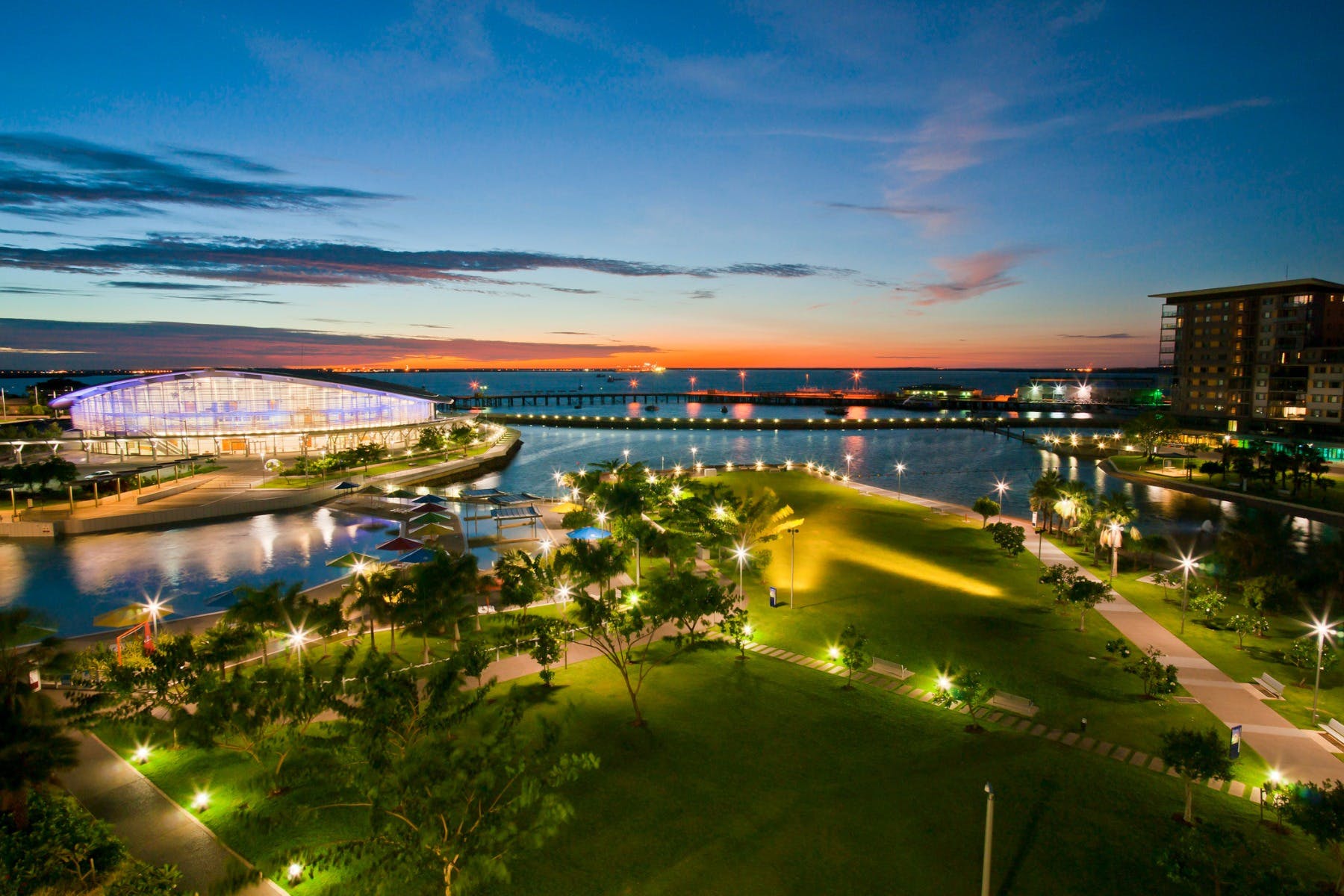
Population: 148,500
Average monthly salary (after tax): $5,541.50 AUD
Unemployment rate: 5.8% (as of July 2020, according to Labour Market Information Portal)
Price for a house outside of the centre: $477,500 AUD
The average summer temperature: 24.7 – 32 °C (water – 30.6 °C)
The average winter temperature: 21.6– 31.8 °C (water – 25.7 °C)
Darwin is the capital of the Northern Territory, and it’s the least populous city among other metropolises. Despite that, the population of Darwin is quite young, with an average age of 33 years old. Some analysts explain this by the fact that retired people move to other cities in Australia. Charles Darwin University, with a capacity of more than 6,800 students, also contributes to the younger population.
The key industries of the city are tourism and mining. Well located (Darwin is geographically closer to Indonesia and East Timor than to any Australian capital), the city plays a vital role in the supply chain and logistics.
As Darwin lies in the zone of a tropical climate, it has only two seasons — a wet one (November – April) and a dry one (May – September). The average air temperature is approximately the same throughout the year.
Because of its location, Darwin experiences a strong Asian influence in terms of the city’s vibes and culture. Here, you can find plenty of cafes and restaurants with Asian food and night markets. At the same time, Darwin preserves Aboriginal culture and art in its galleries and museums. Among outdoors attractions, open-air cinemas, harbour cruises, cage swimming with crocodiles and trekking to waterfalls are the most popular.
Tasmania
Hobart

Population: 246,900
Average monthly salary (after tax): $4,617.24 AUD
Unemployment rate: 5.7% (as of July 2020, according to Labour Market Information Portal)
Price per square meter to buy an apartment outside of the centre: $3,338.50 AUD
The average summer temperature: 11.5 – 21 °C (water – 16.5 °C)
The average winter temperature: 3 – 12.3 °C (water – 12.5 °C)
Hobart is the capital of Tasmania and home to almost half of all citizens on the island. It is the southernmost capital of Australia and a significant seaport. Australian and French expeditions to Antarctica begin their journey from here. It is also a popular destination for numerous cruise ships. The most important industries in the city are shipbuilding, food (breweries, confectionery factories, wine production) and tourism.
Hobart is attractive for its vast number of gourmet restaurants with a variety of excellent quality food, whiskey and craft beer. During the day, you can climb Mount Wellington for stunning views of the city, stroll through the charming local markets, and visit the Museum of Old and New Art (MONA) with its exciting and sometimes provocative collection.
Hobart is home to the University of Tasmania, which offers over 100 undergraduate degrees in various areas, including such exciting directions as maritime engineering, Antarctic, aquaculture and marine conservation.
Launceston
Population: 68,007
Average monthly salary (after tax): $3,441.88 AUD
Unemployment rate: 6.9% (as of July 2020)
Price per square meter to buy an apartment outside of the centre: $3,490.50 AUD
The average summer temperature: 12 – 24 °C
The average winter temperature: 2 – 13 °C
Launceston is a city in the north of Tasmania located 200 kilometres from Hobart. It is one of Australia’s oldest cities, taking pride in a great number of beautiful historic buildings from the 19-20th centuries in Victorian, Georgian, Art-deco and Federation architecture styles. There is also much to see and do outside the town. Explore Cataract Gorge with breathtaking views, take stunning pictures on lavender farms or taste excellent wine in the Tamar Valley.
Launceston lies on the Tamar Riverbank, so low-lying parts of the city are prone to flooding. However, the government is strengthening dams and structures, so floods are rare and do not cause much as much damage as they did decades ago.
The key industries in the city are retail, education, hospitality, construction and manufacturing. It is also famous for viticulture and wool production. The city is home to a University of Tasmania campus that includes the Australian Maritime College.
